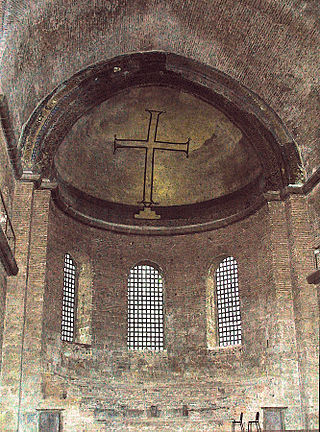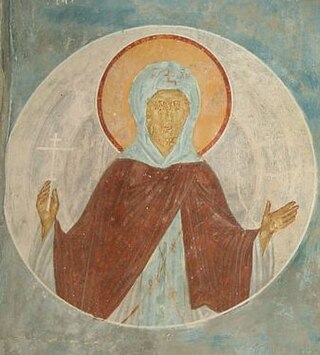Related Research Articles

Leo III the Isaurian, also known as the Syrian, was Byzantine Emperor from 717 until his death in 741 and founder of the Isaurian dynasty. He put an end to the Twenty Years' Anarchy, a period of great instability in the Byzantine Empire between 695 and 717, marked by the rapid succession of several emperors to the throne. He also successfully defended the Empire against the invading Umayyads and forbade the veneration of icons.

Year 843 (DCCCXLIII) was a common year starting on Monday of the Julian calendar.

Theodore the Studite, also known as Theodorus Studita and Saint Theodore of Stoudios/Studium, was a Byzantine Greek monk and abbot of the Stoudios Monastery in Constantinople. He played a major role in the revivals both of Byzantine monasticism and of classical literary genres in Byzantium. He is known as a zealous opponent of iconoclasm, one of several conflicts that set him at odds with both emperor and patriarch. Throughout his life he maintained letter correspondences with many important political and cultural figures of the Byzantine empire; this included many women, such as the composer and nun Kassia, who was much influenced by his teachings.

Leo V the Armenian was the Byzantine emperor from 813 to 820. A senior general, he forced his predecessor, Michael I Rangabe, to abdicate and assumed the throne. He ended the decade-long war with the Bulgars, and initiated the second period of Byzantine Iconoclasm. He was assassinated by supporters of Michael the Amorian, one of his most trusted generals, who succeeded him on the throne.

Michael II, called the Amorian and the Stammerer, reigned as Byzantine Emperor from 25 December 820 to his death on 2 October 829, the first ruler of the Amorian dynasty.
Theophanes the Confessor was a member of the Byzantine aristocracy who became a monk and chronicler. He served in the court of Emperor Leo IV the Khazar before taking up the religious life. Theophanes attended the Second Council of Nicaea in 787 and resisted the iconoclasm of Leo V the Armenian, for which he was imprisoned. He died shortly after his release.

Theodora, sometimes called Theodora the Armenian or Theodora the Blessed, was Byzantine empress as the wife of Byzantine emperor Theophilos from 830 to 842 and regent for the couple's young son Michael III, after the death of Theophilos, from 842 to 856. She is sometimes counted as an empress regnant, who actually ruled in her own right, rather than just a regent. Theodora is most famous for bringing an end to the second Byzantine Iconoclasm (814–843), an act for which she is recognized as a saint in the Eastern Orthodox Church. Though her reign saw the loss of most of Sicily and failure to retake Crete, Theodora's foreign policy was otherwise highly successful; by 856, the Byzantine Empire had gained the upper hand over both the Bulgarian Empire and the Abbasid Caliphate, and the Slavic tribes in the Peloponnese had been forced to pay tribute, all without decreasing the imperial gold reserve.
Petronas was a notable Byzantine general and leading aristocrat during the mid-9th century. Petronas was a brother of Empress Theodora and hence brother-in-law of Emperor Theophilos, under whom he advanced to the high court rank of patrikios and the post of commander of the Vigla guard regiment. After Theophilos' death, he played a role in the ending of Iconoclasm, but was sidelined along with his brother Bardas during the minority of his nephew, Michael III, when power was held by the regent Theoktistos. In 855, Petronas and Bardas encouraged Michael III to seize control of the government: Theoktistos was murdered, Theodora banished to a monastery, Bardas became Michael's chief minister, and Petronas was tasked with the war against the Arabs. In 863, he scored a crushing victory at the Battle of Lalakaon, a feat which marked the gradual beginning of a Byzantine counter-offensive in the East. Promoted to the rank of magistros and the office of Domestic of the Schools, he died in 865.

Lazarus, surnamed Zographos, is a 9th-century Byzantine Christian saint. He is also known as Lazarus the Painter and Lazarus the Iconographer. Born in Armenia on November 17, 810, he lived before and during the second period of Byzantine Iconoclasm. Lazarus was the first saint to be canonized specifically as an iconographer. He was later followed by Saint Catherine of Bologna.

John VII, surnamed Grammatikos or Grammaticus, i.e., "the Grammarian", was Ecumenical Patriarch of Constantinople from January 21, 837 to March 4, 843, died before 867. He is not to be confused with the much earlier philosopher John Philoponos.

The Byzantine Iconoclasm were two periods in the history of the Byzantine Empire when the use of religious images or icons was opposed by religious and imperial authorities within the Ecumenical Patriarchate and the temporal imperial hierarchy. The First Iconoclasm, as it is sometimes called, occurred between about 726 and 787, while the Second Iconoclasm occurred between 814 and 842. According to the traditional view, Byzantine Iconoclasm was started by a ban on religious images promulgated by the Byzantine Emperor Leo III the Isaurian, and continued under his successors. It was accompanied by widespread destruction of religious images and persecution of supporters of the veneration of images. The Papacy remained firmly in support of the use of religious images throughout the period, and the whole episode widened the growing divergence between the Byzantine and Carolingian traditions in what was still a unified European Church, as well as facilitating the reduction or removal of Byzantine political control over parts of the Italian Peninsula.

Joseph the Hymnographer was a Greek monk of the ninth century. He is one of the greatest liturgical poets and hymnographers of the Eastern Orthodox Church. He is also known for his confession of the Orthodox Faith in opposition to Iconoclasm.
Sergios Niketiates was a senior Byzantine official and member of the Amorian dynasty. He is celebrated as a saint by the Eastern Orthodox Church on 28 June for his role in the restoration of the veneration of icons.
This is a timeline of the presence of Eastern Orthodoxy in Greece from 717 to 1204. The history of Greece traditionally encompasses the study of the Greek people, the areas they ruled historically, as well as the territory now composing the modern state of Greece.
Ignatios the Deacon was a Byzantine cleric and writer. Left an orphan as a child, he was educated under the auspices of Patriarch Tarasios of Constantinople, and rose in the church hierarchy under Tarasios' successor, Nikephoros I, becoming a deacon and skeuophylax of the Hagia Sophia. After the start of the second period of the Byzantine Iconoclasm ca. 814, he sided with the iconoclasts, becoming metropolitan bishop of the prestigious see of Nicaea, probably in the 830s. He later reversed his stance, however, and retired as a monk at about the time of the definite end of Iconoclasm in 843. Ignatios was the confirmed or probable author of several saints' lives (hagiographies), funeral elegies, letters and poems.

Saint Symeon Stylites of Lesbos (765/66–844) was a monk who survived two attempts on his life during the second period of Byzantine Iconoclasm (814–842). He followed a similar model to Simeon Stylites, residing on a pillar-like structure similar to a tower. There he isolated himself from the world and fasted, prayed and studied. He is venerated with his two brothers, Saint George the Archbishop of Mytilene and Saint David the Monk.

Thekla, latinized as Thecla, was a princess of the Amorian dynasty of the Byzantine Empire. The daughter and eldest child of Byzantine emperor Theophilos and empress Theodora, she was proclaimed augusta in the late 830s. After Theophilos's death in 842 and her mother becoming regent for Thekla's younger brother Michael III, Thekla was associated with the regime as co-empress alongside Theodora and Michael.
Meletios the Younger (c. 1035 – c. 1105), also called Meletios of Myoupolis, was a Byzantine Greek monk, pilgrim and priest. He is venerated as a saint in Eastern Orthodoxy and his feast is celebrated on 1 September.

The Council of Constantinople of 843 or the Synod of Constantinople of 843 was a local council of Christian bishops that was convened in Constantinople in AD 843 by the Byzantine regent Theodora to confirm iconophilism in the Church. This council is still celebrated on the first Sunday of Great Lent in the Eastern Orthodox Church, as presecribed by the council. After the council which was under the presidency of the Patriarch Methodios I, the attendees met on 11 March 843 and symbolically processed from the Blachernae Church to the Church of Hagia Sophia bearing an icon of the Mother of God.

Theodora of Thessaloniki (812–892) was a Byzantine nun and saint from Aegina. Her vita is the longest ever written about a holy woman in Byzantine history and the Eastern Orthodox Church celebrates her feast day on 29 August.
References
- ↑ OrthoChristian.
- ↑ Talbot 1996, p. 160.
- ↑ Talbot 1996, p. 172.
- 1 2 Domínguez 2021, p. 234.
- ↑ Talbot 1996, pp. 177–178.
- ↑ Talbot 1996, p. 178.
- ↑ Talbot 1996, p. 179.
- ↑ Efthymiadis 2013, p. 120.
- ↑ Shephard 2005, p. 308.